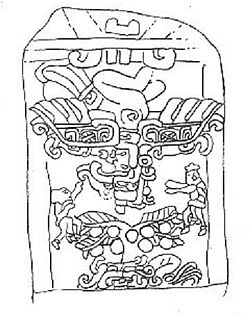Izapa
Izapa is a very large pre-Columbian archaeological site located in the Mexican state of Chiapas; it is best known for its occupation during the Late Formative period.
Due to the abundance of carved Maya stelae and monuments at Izapa, the term "Izapan style" is used to describe similarly executed works throughout the Pacific foothills and highlands beyond, including some found at Takalik Abaj and Kaminaljuyu.
[4] "The core area of Izapa is formed by Groups A to E, G and H, which correspond to the period of the greatest apogee of the site, circa 300 B.C.
Groups A, B, and F are open for tourism today through Mexico's National Institute for Anthropology and History (Instituto Nacional de Antropología e Historia).
[6] This hypothesis is supported by the fact that Izapa fits the geological and historical conditions better than the previous place thought to be the origin.
There are common characteristics of Izapan art, such as winged objects, long-lipped gods much like the Chaac of the Maya,[8] Olmec-like swirling sky and clouds, feline mouth used as frame, representation of animals (crocodile, jaguar, frog, fish, birds), overlapping, and lack of dates.
Although this could imply that the Izapan culture lacked knowledge of any writing system, Julia Guernsey, author of a definitive work on Izapa sculpture, proposes instead that the monuments were intentionally language-free and that "Izapa's position at the juncture of two linguistic regions [i.e. Mixe–Zoque and Maya] may have fostered the penchant for non-verbal communicative strategies.
[citation needed] Among the possible Izapa glyphs discussed by scholars are some that are known as “U Shape”, “Border Panel” (skyband), and “Crossed Band”.
[11] Izapa Stela 1 features a long lipped deity, which Coe describes as the early version of Maya god of lightning and rain, Chaac.
The complexity of the imagery has led some fringe researchers, particularly Mormon and "out of Africa" theorists, to view Stela 5 as support for their theories.
A striking parallel exists between the imagery of Chalcatzingo Monument 1 and Izapa Stela 8, both of which feature elite individuals enthroned within a quatrefoil.
The image depicted on Stela 25 is most likely the Maya Hero Twins shooting a perched Principle Bird Deity with a blowgun.
It is also suggested that Stela 25 could be seen as a map of the night sky, which was used to tell the story of the Hero Twins shooting the bird deity.
[14] In 1941, Matthew Stirling working on behalf of the National Geographic and the Smithsonian Institution conducted a week of excavations at Izapa to better reveal some of the carved monuments.
From 1961 to 1965 Gareth Lowe directed four seasons of excavations at Izapa as behalf of the New World Archaeological Foundation (an organization run out of Brigham Young University).
[16] The NWAF excavations emphasized the discovery of monuments and understanding the construction history of Izapa's central plazas.
[17][16] After a hiatus of 25 years, excavations resumed at Izapa under the direction of Hernando Gómez Rueda, working for Mexico's Instituto Nacional de Antropología e Historia (INAH).
Gómez Rueda suggested several possible roles for Izapa's hydraulic system, including distribution of water throughout the site, pools for raising edible aquatic species, and a hybrid ceremonial-functional use.
Over four seasons of survey between 2011 and 2015 director Robert Rosenswig, a professor at the University at Albany, and his team used lidar (light detection and ranging) to map sites and collect surface ceramics to document changing population trends at Izapa and nearby areas.




